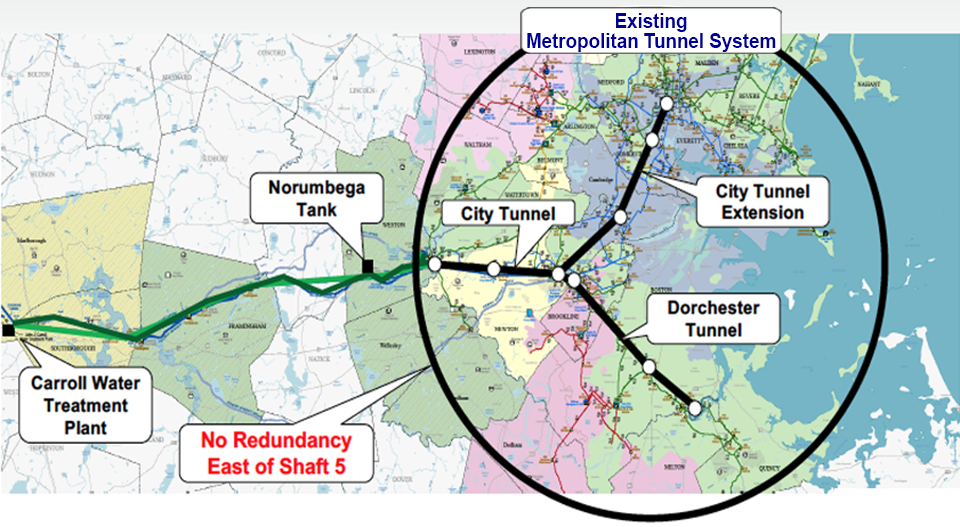Overview
Through the Metropolitan Water Tunnel Program (Tunnel Program), MWRA will construct two new water supply tunnels that will provide redundancy for MWRA's existing Metropolitan Tunnel System, which includes the City Tunnel (1950), City Tunnel Extension (1963) and Dorchester Tunnel (1976). The Tunnel Program will also allow our aging existing water tunnel system to be rehabilitated without interrupting service. The Tunnel Program is in the preliminary design and environmental review stage. Final design will begin after preliminary design is complete, with tunnel construction planned to occur from approximately 2027 through 2038.
Background
MWRA provides wholesale water and wastewater services to over 3.1 million customers in 61 communities in eastern and central Massachusetts with most service communities located in the Greater Boston area. The Quabbin Reservoir and Wachusett Reservoirs, which are the main water supply sources, are located 65 and 35 miles west of Boston, respectively. Water from the reservoirs is treated in the Carroll Water Treatment Plant before transmitting to the Greater Boston area through a number of existing tunnels and aqueducts.
A redundant water transmission system exists for approximately 25 miles from the Wachusett Reservoir to the beginning of the existing Metropolitan Tunnel System.
The existing Metropolitan Tunnel System carries approximately 60% of the Metropolitan Boston area's daily demand through the remaining 19 miles of tunnels. With no redundancy to the Metropolitan Tunnel System, partial system shutdowns for planned maintenance of the aged infrastructure or unplanned emergencies cannot take place.
The planned Tunnel Program will provide redundancy for this crucial part of our water infrastructure.
Why Redundancy?
Redundancy in the water supply infrastructure has been part of the plan as early as 1937 for the reliability of service and operational maintenance. Various versions of tunnel loops and redundant tunnels have been proposed over the years.
A significant portion of these plans have been implemented. With the completion of the MetroWest Water Supply Tunnel in 2003, the water transmission system has redundancy from the John J. Carroll Water Treatment Plant to the beginning of the existing Metropolitan Tunnel System.
The Metropolitan Tunnel System was constructed in the 1950s to the 1970s and has been in continuous service ever since. While the concrete-lined deep rock tunnels have a long design life, some of the associated valves and piping are in poor condition after over 50 years. In order to exercise, service and replace some of these valves and piping without interruption to water supply, a redundant system is required.
Valves in need of repair, rehabilitation or replacement
Program Goals
The Tunnel Program was conceived to address several outstanding challenges, most notably the fact that the existing Metropolitan Tunnel System cannot be maintained or repaired nor can an emergency be readily addressed because shut down of the system is not currently possible without imposing a boil-water order.
The first and foremost goal of the Program is an operational goal; to protect public health, provide sanitation, and provide fire protection. The MWRA exists to provide these services. In support of this overall goal, the Program is intended to:
- Provide full redundancy for the Metropolitan Tunnel System:
- Provide normal water service and fire protection when the existing tunnel system is out of service
- Provide the ability to perform maintenance on existing tunnels year-round
- Provide uninterrupted service in the event of an emergency shut down
- Meet high day demand flow with no seasonal restrictions
- Avoid activation of emergency reservoirs
- Meet customer expectations for excellent water quality
- Preserve sustainable and predictable rates at the water utility level
- Minimize cost of borrowing
- Be constructible
- Result in no future boil water orders
The selected tunnel alternative is expected to meet all of these goals.
Back to top
Updated
June 22, 2023
PDF files on this site require Adobe Acrobat Reader (free download)


